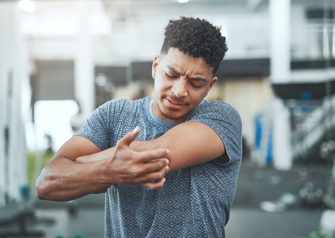
News
How to Avoid Overuse Injuries
Date posted: 2/7/2023
Last updated: 2/8/2023
Table of Contents
Whether you’re a year-round athlete or someone just beginning a fitness routine, you are at risk of an overuse injury. Overuse injuries occur with repetitive stress to bones, tendons, muscles, and ligaments. They can occur in all parts of the body and typically affect the joints involved in your specific sport. Some common overuse injuries are tennis elbow (lateral epicondylitis), shin splints, Achilles tendonitis, stress fractures, bursitis, and growth plate injuries in children (apophysitis).
Risk factors for overuse injuries
The two most important causes of overuse injuries are training errors and poor technique.
Training errors: Doing too much of an activity, increasing the workload too quickly, and not allowing enough time for recovery puts the body at risk of developing an overuse injury. Sport specialization or playing one sport year-round is a risk factor specific to children and teenagers.
Poor technique: Playing a sport without proper form or equipment may involve muscles, bones, and ligaments that are not conditioned for the demands of the sport. The repetitive stress of a golf swing, running stride, or softball pitch may be too much stress for the body and result in an overuse injury.
Muscle tightness and weakness can also make overuse injuries more likely to develop. When children and teenagers are growing, their bones grow faster than their muscles. This muscle tightness can change how force is distributed through a joint and make overuse injuries like Osgood-Schlatter syndrome (tibial tubercle apophysitis) more likely. Muscle weakness can contribute to poor form and cause overuse injuries throughout the body in patients of all ages.
Symptoms of Overuse Injuries
Overuse injuries cause pain in one specific spot which gets worse with activity. Eventually, these symptoms may limit sports activities or cause pain with normal daily tasks.
Preventing Overuse Injuries
There are many ways to lessen the risk of overuse injuries:
- Gradually increase activity: Before starting a new season or training plan, slowly build up the volume and intensity of exercise. The “rule of 10%” is a helpful way to do this. For example, a runner might increase their overall mileage by 10% per week. This allows a safe progression of training and reduces the risk of injury.
- Allow time for rest and recovery: The body needs time away from exercise to rebuild and prepare for the next session. Most people will need at least one full day off from sports per week.
- Include cross-training: Different sports place unique demands on the body and including other activities in your training may address imbalances and prevent overuse injuries. Low impact aerobic activities like swimming, cycling, or the elliptical machine can help increase cardiovascular fitness while putting less stress on the bones and muscles. Strength training can help improve muscle weakness and yoga or mobility work can address muscle tightness.
- Consider playing multiple sports: Current guidelines recommend that children and teenagers take a total of 3 months off per year from their primary sport. The child can remain active during this time including playing other sports. This allows their body to recover and develop other skills which may improve their performance in their primary sport.
- Use proper form: Whether you’re starting a new sport or want to improve your technique, consider taking lessons.
- Check your equipment: Any training aids or sports equipment should be in good working condition and free from major damage. Using an old tennis racquet or hockey skates may cause you to use poor technique and increase the risk of injury. Shoes are an important part of many sports and should be replaced every 12 months or every 300-500 miles for runners.
- Address strength or flexibility issues: Tight hamstrings, weak hip rotators, and weak shoulder stabilizers commonly contribute to overuse injuries. If a doctor or physical therapist has identified these issues in you, consider asking for some exercises to address these problems.
- Maintain healthy habits: Getting adequate sleep, having good nutrition, and staying hydrated will give your body the building blocks it needs to repair the normal microtrauma from exercise and prevent developing an overuse injury.
Treatment for Overuse Injuries
If you’re experiencing localized pain that gets worse with activity, consider making an appointment with one of our providers today.
About Caitlin Nicholson, MD
Dr. Caitlin Nicholson is a Primary Care Sports Medicine Physician who specializes in the non-surgical treatment of musculoskeletal injuries. She believes that excellent patient care begins with attentive listening and a detailed evaluation. Her treatment plans are individualized to each patient and involve targeted interventions through physical therapy, injections, or bracing to help the patient return to their activities.
